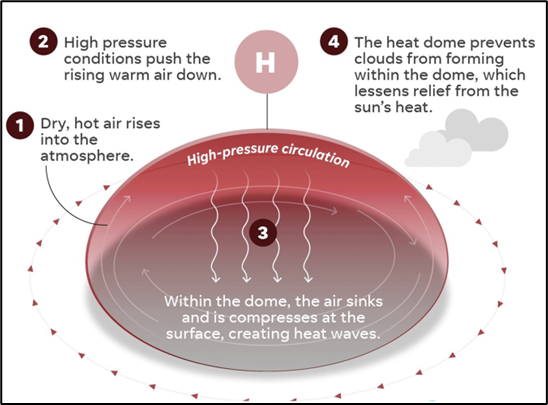Why in News?
- Several parts of Europe is witnessing an unprecedented winter heat wave.
- Calling it an “extreme event”, experts said that temperatures increased 10 to 20 degrees Celsius above normal.
- According to a report published in the Washington Post, the continent is experiencing an extreme warm spell because of the formation of a heat dome over the region.
What’s in today’s article?
- What is a Heat Dome?
- What is the relationship between heat domes and the jet stream?
- Is Climate Change responsible for heat domes?
- News Summary
What is a Heat Dome?

- A heat dome occurs when an area of high-pressure traps warm air over a region, just like a lid on a pot, for an extended period of time.
- The longer that air remains trapped, the more the sun works to heat the air, producing warmer conditions with every passing day.
- Heat domes generally stay for a few days but sometimes they can extend up to weeks, which might cause deadly heat waves.
- Scientists suggest that any region of high pressure, whether a heat dome or not, forces air to sink and once it reaches the ground, it gets compressed and becomes even warmer.
- Moreover, when air sinks, it gets drier and further raises the temperature of the area.
What is the relationship between heat domes and the jet stream?
- The heat dome’s formation is related to the behaviour of the jet stream — an area of fast-moving air high in the atmosphere.
- The jet stream is believed to have a wave-like pattern that keeps moving from north to south and then north again.
- When these waves get bigger and elongated, they move slowly and sometimes can become stationary.
- This is when a high-pressure system gets stuck and leads to the occurrence of a heat dome.
Is Climate Change responsible for heat domes?
- Although heat domes are likely to have always existed, researchers say that climate change may be making them more intense and longer.
- They suggest with the rising temperatures, it is expected that the jet streams will become more wavy and will have larger deviations, causing more frequent extreme heat events.
News Summary:
- On the first day of the year, seven countries in Europe recorded their warmest January.
- Temperatures were at least 10 to 20 degrees Celsius above normal from France to western Europe.
- Climatologists suggested that the temperatures surged to summer or springtime levels.
- For example, at Korbielów, a small village in Poland, the mercury reached 19 degree Celsius – a temperature the region is more used to in May.
- It is 18 degree Celsius above the one degree Celsius yearly average for January.









